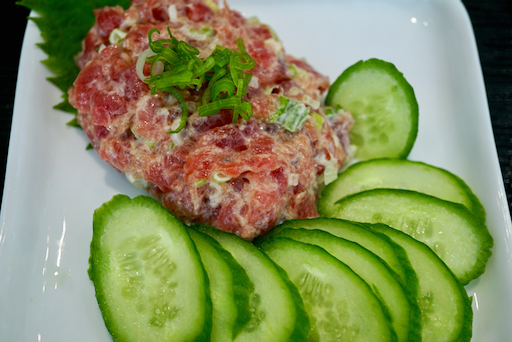I started
going back to our Japanese grocery store again. The last time, I got
a fairly good hamachi sashimi. This time, I hit the jack pot! I knew that the Japanese grocery store gets sashimi bluefin tuna or “hon-maguro” or “kuro-maguro” once a month but I did not try to find out when and never went specifically to get sashimi maguro. Just by happenstance I went just a day after they got the maguro. So I had a choice of chu-toro or akami maguro sashimi. I chose a package of “akami” with two good sized portions and also, as an added benefit, some hamachi. That evening, we had a combination sashimi feast of tuna 鮪, hamachi はまち, vinegar cured mackerel しめ鯖 (frozen). I also made imitation “
negitoro” 擬制ねぎとろ from this tuna sashimi because the tuna portions were not regular “saku” 柵 blocks for sashimi and I ended up with some odd pieces after slicing the sashimi pieces. Compared to our usual imitation negitoro which I make from a frozen block of yellofin tuna, this was much much better. I did not take any pictures, however. Next evening, I served the remaining sashimi, deep fried fish cake or “satsuma-age” さつま揚げ which I also got at the Japanese grocery store (heated in the toaster oven served with soy sauce and grated ginger). I also made a sort of new dish from cod-roe and nagaimo.
The next picture shows the “new” nagaimo dish I made. I did this because I had thawed “tarako” たらこ cod roe and found out the membrane in the back was already broken. So, I removed the roe from the remaining sac, mixed it with a small amount of sake, although I did not have a firm idea at the time of what I would make from it. I then remembered that we had a small segment of
nagaimo 長芋 in the refrigerator which had to be used soon. So I just combined the two. I garnished it with a chiffonade of perilla and nori. This was a good dish. This tarako was a bit on the salty side but the addition of sake in combination of the crunchy refreshing nagaimo, really worked.
Ingredients:
1 inch segment of nagaimo, skinned, sliced and cut into fat match sticks.
1 tsp sake
One sac of salted tarako, cod roe
Perilla leaves and nori chiffonade for garnish
Direction:
Soak the nagaimo sticks in water with a splash of rice vinegar and gently wash to remove surface sliminess. Blot dry using a sheet of paper towel.
Remove the roe from the sac using the back of the knife and mix it with 1 tsp of sake. Taste and if not salty enough, add soy sauce (mine was salty enough).
Dress the nagaimo and garnish it with the perilla.
So every time I go to our Japanese grocery store, we have a number of “goodies” for dinner that evening.





















